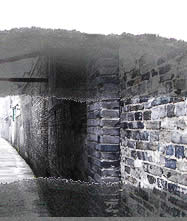|
1. Ancient bridges
Up until 1998, there were 104 old bridges, all of which were built during the Ming and Qing dynasties. These include the bridges of Anren, Anjing, Anshan, Wufu, Qingning, Wolong and Laifeng. Most of them are single- or triple-arched wooden beam bridges with stone piers.
The Wufu (Five-Bliss) Bridge
It was built during the Ming Dynasty and renovated during the reign of Emperor Guangxu in the Qing Dynasty. The single-arched bridge with a stepped floor is 14 meters long and 7.5 meters wide.
The Wolong (Crouching-Dragon) Bridge
Built during the reign of Emperor Kangxi in the Qing Dynasty, this single arched stone bridge is 31.46 meter long, 4.95 meters wide, and 5.5 meter high, the highest of its kind in Xitang. There are 32 steps on the bridge's east slope and 30 on the west. An additional nine on a ramp annexed to the west slope make it easier to walk across it.
2. Riverwalk Canopies
The unique canopies, covering most of the town's riverside walks, add to the attraction of this beautiful water town. The canopies provide much needed shelter from the sun and the rain, and are the perfect place to sit under on benches along the riverwalks. Most of the road canopies, 2-2.5 meters wide, are wooden-famed structures with tiled roofs. End to end, the canopies stretch for a total of over 1,000 meters.
3. The maze of alleyways
Alleys snaking around residential complexes are another distinctive of this ancient town.
The most famous alley is called "Stone-Paved Lane." It is 68 meters long and only a meter wide, paved with 216 slabs of stone.
But "Stone-Paved Lane" isn't the narrowest to be found. That honor goes to two alleys. One can be found at the Li House. It's so narrow that only one person can pass at a time, and sideways. The other, called "Wildcat Lane," is barely 30 cm wide. Located at the west end of the Huanxiu Bridge, it is actually a passage that separates two houses.
By contrast, the widest of Xitang's alleys walks five and half people standing shoulder to shoulder. It is also located by the Li House, which is by the Shaoxianggang.
The shortest of the alleyways, only 3 meters long, is found in the complex of Yuqing Residence.
The longest, the Sixian (Four-Sage) Temple Lane, is 236 meters long and it sits on Beishan Street.
4. Places of special interest
The Zhongfu House
This residential compound built in the Ming and Qing styles, features a seven-fold serial courtyard with a garden in the back. It was the home of the prominent Wang family during the Qing Dynasty.
The Xue House
The house was built into a business-residential complex during the years of the Republic of China (1911-49). Located in a bustling commercial area, the house had a specialty food store at the front and living quarters at the back. With the front of the house facing the street and the back on the waterfront, the design is typical of the town's commercial-residential buildings.
Sheng Tang (The Sage's Temple)
Originally built during the Ming Dynasty, the temple was renovated twice during the years of Emperor Kangxi in the Qing Dynasty. The renovated building was dedicated to Lord Guan (Yun-chang), a military hero who lived in the third century BC. Spring Festival celebrations were often held here.
The Ni House
This five-fold courtyard was home to the Nis, a literary family. Street canopies line the front of the compound, and a garden provides green serenity at the back of the complex.
Xi Yuan (Western Garden)
The home of a celebrated Zhu family that lived in southeastern China, this old residence boasts requisitely built towers, pavilions, rockeries and a fish pond. Some say the pond is the finest-looking spot in the whole town.
5. Museums
Valuable as they are architecturally and culturally, some of these heritage houses today serve as public or private museums. On display is a wide of range of items including historical documents or collections of old bamboo carvings, wood sculptures, decorative bricks and tiles. In the private museums, residents have even been known to open their lounges or studies to visitors for having a good old chat. More fortunate visitors might even be treated to private ancient book collections and inscriptions.
Root-Sculpture Museum of Mr. Zhang Zheng
About 300 root sculptures are on display in the museum's four exhibition rooms. Each of the rooms has a name: Guinness World Records, Eagles, Buddhist Images and the Underwater World.
Tile-Ends Museum
Ancient tile-ends are considered curios, because only a few remain today. They are decorative tiles made inexpensive materials. In this museum, there is a good collection of over 300 items. Also on display are patterned gutters, carved bricks, antique bricks, and pottery figures.
Wood-Carving Museum
Some of the 250 residential wood decorations exhibited here date back to the Ming and Qing dynasties. The works include carved beam heads, balustrades and window shades, as well as lattice windows. The elegant and exquisite designs are a demonstration of just how skilled ancient craftsmen and artisans were.
Button Museum
Xitang is also known as "button country." The museum has a collection of over 1,000 buttons; buttons through the ages.
|







